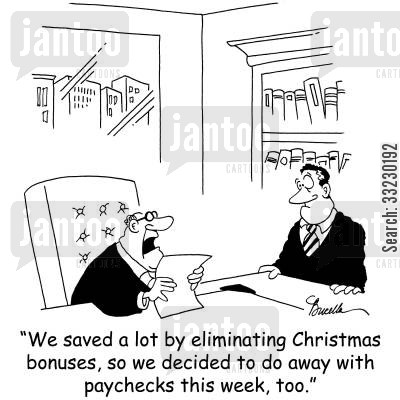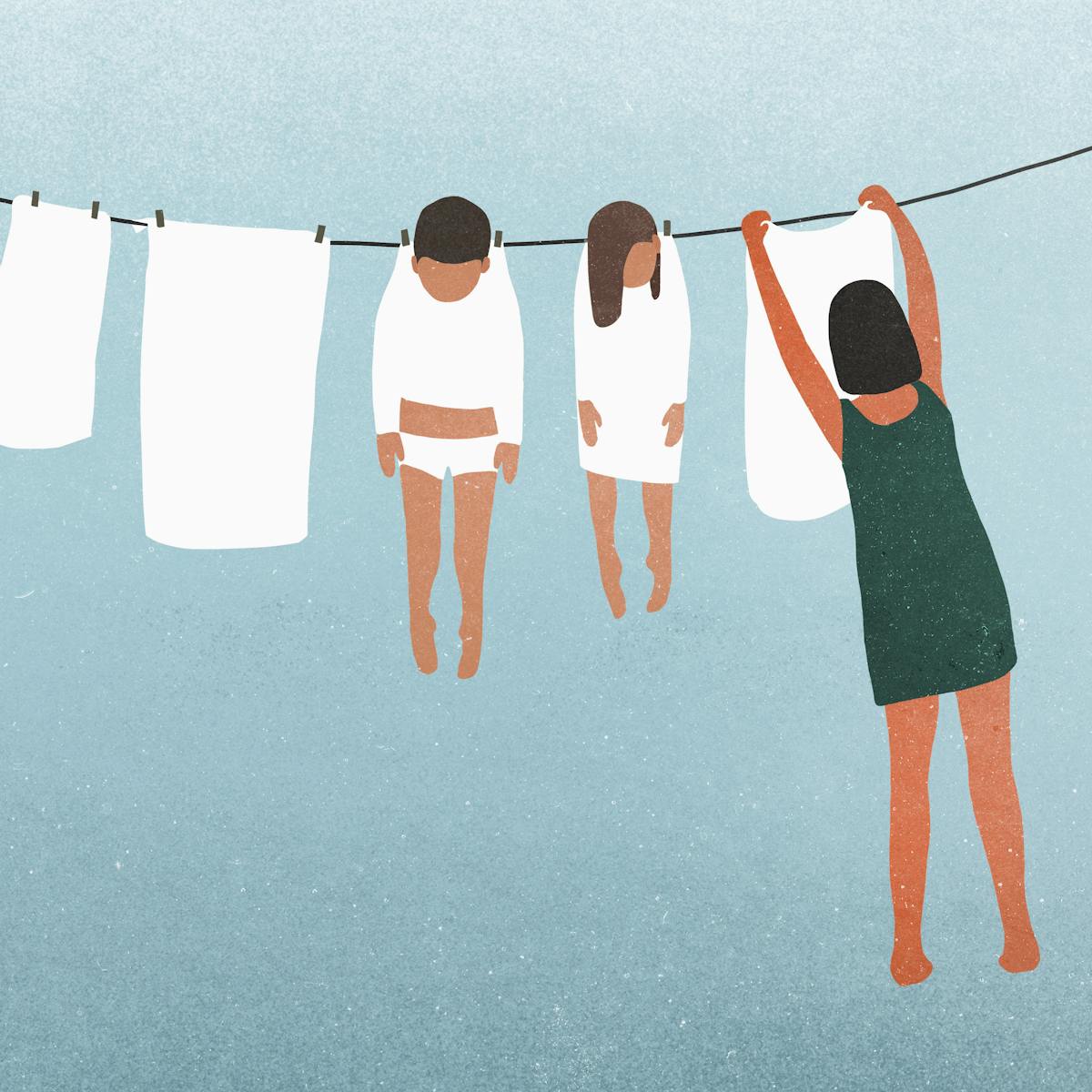
Cartoon – 2020 Holiday Bonus Outlook





U.S. states saw another 840,000 jobless claims filed last week, as the number of Americans applying for first-time unemployment insurance benefits each week continues to hover at a historically high level.
The U.S. Department of Labor (DOL) released its weekly jobless claims report at 8:30 a.m. ET Thursday. Here were the main metrics from the report, compared to Bloomberg estimates:
New weekly unemployment insurance claims have held below the psychologically important 1 million mark for the past six consecutive weeks, but have so far failed to break below 800,000 since the start of the pandemic. At 840,000 last week’s new claims remained at a level still handily above the pre-pandemic record high of 695,000 from 1982.
The past two weeks’ jobless claims totals have also been flattered by an absence of updated new claims out of California. The state – which has consistently been one of the biggest contributors to new weekly claims – announced last week it was taking a two-week pause in processing initial claims to “reduce its claims processing backlog and implement fraud prevention technology,” according to the Labor Department’s statement.
Across all programs, the total number of jobless claims decreased for the week ending Sept. 19. Total claims came in at 25.5 million, down from the about 26.5 million during the previous week, as a smaller number of self-employed or gig workers not eligible for regular state programs claimed Pandemic Unemployment Assistance. But the number of workers collecting benefits through the Pandemic Emergency Unemployment Compensation Program – which offers an extra 13 weeks’ worth of federal benefits to those who had exhausted previous state or federal compensation – rose by 154,000 to 1.96 million.
Continuing jobless claims, which are reported on a one-week lag and represent the total number of individuals still receiving state unemployment benefits, continued their gradual downtrend last week. But as with new jobless claims, continuing claims have held well above pre-pandemic levels, and have not broken below the 10 million mark in more than 6 months.
“Net, initial filings fell less than expected last week. The improvement in continuing claims is reflecting people being hired but also individuals exhausting their benefits,” Rubeela Farooqi, chief economist for High Frequency Economics, said in an email. “Overall, the signal from the claims data is still one of ongoing weak conditions in the labor market. Even as filings are declining, levels remain extraordinarily high. Employment growth has already slowed and without fiscal support that protected jobs, risks are skewed to the downside for payrolls going forward.”
The latest jobless claims report comes amid dimming hopes for another round of virus relief measures out of Congress, despite increasingly urgent calls from Federal Reserve officials for more fiscal stimulus to support individual Americans more directly.
President Donald Trump said Tuesday he had asked his negotiators to halt further stimulus talks until after the election, but added that he would support standalone measures providing tens of billions of dollars for airline payroll support and the Paycheck Protection Program. House Democrats, however, have previously balked at the notion of passing slimmed down versions of a stimulus package – meaning the prospect of further fiscal stimulus in the next month remains unlikely.

https://www.healthcaredive.com/news/hca-seeks-nurse-backup-ahead-of-potential-strike/579502/

Nashville-based HCA Healthcare, the largest among for-profit hospital operators, has received the most among for-profits in Coronavirus Aid, Relief and Economic Security Act funding so far, about $1 billion. The amount is about 2% of HCA’s total 2019 revenue.
The 184-hospital system said it has not had to furlough any employees like other systems have, though some employees have been redeployed or seen their hours and pay decrease. HCA implemented a program providing seven weeks paid time off at 70% of base pay that was scheduled to expire May 16, but extended through June 27.
An NNU spokesperson told Healthcare Dive the program isn’t technically a furlough because some HCA nurses participating said they must remain on call or work rotating shifts.
The union spokesperson also confirmed that an email was sent to HCA nurses referring them to the strike-nurse job posting, which would offer more pay than their current roles.
“This really is a threat to nurses, and particularly insulting when you already have layoffs or cuts, if you don’t accept further concessions,” a union spokesperson told Healthcare Dive.
Nurses in California joined those in five other states at the end of May to protest HCA’s proposal to cut wage increases or impose layoffs.
At HCA’s Regional Medical Center in San Jose, California, NNU filed a suit to block the closure of the maternal-child care center, which it said is in violation of laws to protect the health and safety of the community. The closure proceeded anyway on May 30, followed by an announcement from Santa Clara County that the move may be jeopardizing the facility’s Level II Trauma designation agreement.
Across the country, frontline caregivers continue noting a lack of adequate personal protective equipment. The union’s executive director, Bonnie Castillo, will testify before Congress on Wednesday on protecting nurses during the pandemic and the dire need for optimal PPE.


I have a Ph.D. from Harvard and a 20-month-old child.
Without child care, life revolves around the toddler.
I am a political science professor and researcher, but lacking child care, I count myself lucky to work a few hours each day.
I am increasingly aware there is no such thing as the so-called work/family conflict. This is not only a personal observation. Scholars have found that good jobs – full-time, with benefits – and family, without help, are simply incompatible.
The concept is also wrong. If three-quarters of American women become mothers, and also most women do paid work, then doing both is, well, life; it’s not some existential, context-free choice.
Work and family are both full-time pursuits. If the problem is framed as a choice between them, the battle is lost, since family will usually win. Telecommuting and “workplace flexibility” are important but do not make up for a lack of time and space to think and work.
Those who need care, especially little children, are needy and adorable, and mothers are evolutionarily disposed to focus on them.
(Whoops, excuse me, the toddler is trying to kill herself again … OK, child saved, with minimal screaming on both of our parts. Now what was I thinking? Did I reorder all our prescriptions? Hold on, I’ll be back.)
The national shift to home-based work and schooling has had challenging consequences for parents, especially mothers. Sometimes these effects are lovely, like giving us more time with family, but if your goal is getting work done, good luck to you.

Working at home these days without child care is incredibly difficult unless I can escape to another room and close a door. This inevitably triggers screaming, but oh well.
She’s worse than a cat; she climbs on me, presses things on the computer, sucks its edges and screams for attention, in addition to the normal baby bodily functions that comprise a disproportionate section of my thinking – when did she last poop? Is that a rash?
It’s not just me.
Submissions from women to academic journals have plummeted since COVID-19 hit.
One geography professor tweeted, “It’s hard enough to keep my head barely above the water with the kids at home and interruptions every 2 min … I can’t imagine writing a paper now.”
Another scholar said the data on diminished submissions from women made her cry because it wasn’t just her.
It turns out that someone has to supervise – and sometimes force – children’s learning, even if online, and this takes actual work. With parks, museums, sports, pools and movie theaters closed, and with kids mostly unable to hang out with friends, someone also has to do the physical and emotional labor of keeping children busy, engaged and upbeat. This too is work.
Then there is the simple fact that family members are eating, working and playing in houses most of the time, which means more cooking, more cleaning, more grocery shopping and, yes, more toilet paper.
(OMG the baby took a two-hour nap. I got to exercise and even shower. No time for leg-shaving but I’m still a new woman. Now what was I thinking…)
Because it is not just time, you see. Sometimes the child is playing quietly, and theoretically I could sit down and bang out a research article, but my brain is fuzzy as hell.
I used to wonder what cows thought, standing there chewing their cud in a field. Now I know. They are thinking nothing. Especially with the nursing, I have great sympathy with cows lately.
Before the baby, and before COVID-19, I had great plans for composing scholarly articles in my head during all that nursing downtime. But I forgot that hormones can change your brain and behavior.

Feminist theory and research finds that much of what people think of as “biological sex” – female or male – is socially constructed, as in, strongly based on culturally contingent assumptions about women and men as groups. I firmly believe, and teach, this as evidence-based truth.
Hormones, though, have undeniable physical and mental effects. If they are turning your body into a milk-production and child-protection facility, there can be some side effects on brain function. Many of these changes (increased empathy and vigilance) are useful evolutionarily, and the physical alterations appear to be short-lived. But there can also be negative effects on memory and focus. If your brain is your job, as mine is, this can cause some serious work disruption.
Pat Schroeder had two young children when first elected to Congress as a Democrat from Colorado in the 1970s. When asked how she could do both jobs, she famously replied, “I have a brain and a uterus, and I use them both.”
I try to live up to Schroeder’s standard, but lately I’ve found I have to qualify it; I tell myself she meant sequentially, not simultaneously.
Sequential is fine, as long as I have time and space to switch gears – I’m a first-time mom at 40 and the gears sometimes stick or stall out – and the peace of mind to focus beyond the child and the never-ending housework. We don’t call this “women’s work” anymore, and men do more than they used to, but it’s essential work and still mostly done by women.
With luck and science, COVID-19 will recede soon, and we can trickle back to offices, for which I have a newfound respect.
Will the U.S. take something positive from this crisis by learning an enduring lesson about the power of child care?
Americans tend to think of having children as an expensive, private choice. The alternative is to think of it as a public good.
Other countries offer far more generous parental leave and low-cost, high-quality daycare, knowing that “work versus family” is a false formulation. The U.S. is losing serious talent and promoting gender inequality by continuing to misunderstand the problem.
There are many potential options when child care is made a priority in a society.
Government subsidies for child care centers would help low-income workers have access to good care. The U.S. almost managed this in 1971, when Congress passed, on a bipartisan vote, a bill to establish child care centers across the country, funded in part by the federal government. President Richard Nixon vetoed the bill.
Universal pre-K starting at age 3, as in New York City, is another option to advance the interests of working parents and children.
And because working parents are drowning in high child-care costs, the government could offer subsidies and tax relief for curriculum-based care – which encourages child development and learning as well as safety – for those early years. I make a pretty good salary, but still, an extra US$1,000 a month or more to ensure my child is safe and well cared for while I work is painful.
It’s not a work-family conflict; it is a lack of high-quality, low-cost child care. Framing the problem otherwise damages the ability to enact good solutions.
It also makes a lot of good, hardworking parents feel enduring guilt over a problem that isn’t theirs alone to solve.

In a legal filing, attorneys for Purdue Pharma asked a judge to authorize millions in payments to employees who have met “target performance goals.”
It is not clear from the company filings why employees would be eligible for bonuses, because, while the bonuses are supposed to be partly contingent on the company’s financial performance, the company has filed for bankruptcy.
At a bankruptcy court hearing in White Plains, N.Y., on Tuesday, Paul K. Schwartzberg, an attorney for the U.S. Trustee, raised objections to some of the bonuses. While it is typical for companies in bankruptcy to try to pay employees as a firm seeks to regain its financial footing, the Purdue Pharma bonuses go “way beyond” what is typical, he said.
The company is widely blamed for fueling the opioid epidemic because of allegedly misleading sales tactics it used to push physicians to prescribe millions of doses of its OxyContin painkiller. It faces thousands of lawsuits from cities, states and others affected by the opioid crisis, which claimed more than 200,000 lives in the past two decades.
“That $34 million is owed to the victims of the opioid epidemic, and every last cent should be spent on addiction science, treatment and recovery,” Connecticut Attorney General William Tong said in a statement to The Washington Post. “Purdue and the Sacklers still don’t seem to comprehend the pain and suffering they have caused. While I am sympathetic to the workers at Purdue, many of whom live in my hometown and state and had nothing to do with the egregious actions of their employer, this not business as usual.”
The attorneys for Purdue Pharma did not specify which of its 700 employees would be eligible for the bonuses, except that the incentives would not be available to “insiders” or any top executives involved in the company’s “strategic decision-making.” But other senior managers, who are often offered such incentive plans, could be eligible for the bonuses.
The number of employees eligible for the bonuses and the amounts of their rewards are unknown. But if the $34 million in bonuses were distributed equally to each of the 700 employees, each would receive about $50,000.
Company attorneys say the incentives are needed to retain key employees as it seeks to transform itself into a public trust aimed at delivering addiction remedies. Since 2018, about a quarter of the company’s “top tier” employees have left, they said.
“These employees have highly coveted skills in the industry and the company is not an easy place to work right now,” Eli J. Vonnegut, an attorney representing Purdue Pharma, said at the bankruptcy hearing. It “would be very difficult to attract new talent were the company to lose its current employees. With all the negative publicity, many employees are concerned about the economic risks that they are taking by staying at Purdue.”
The employee bonuses are part of the company’s long-standing incentive programs, according to the company. It is asking the bankruptcy court’s permission to pay out $26.5 million under its “Annual Incentive Plan,” which covers one year of company and employee performance, and another $7.9 million under its long-term rewards plan, which covers the last three years.
Under both programs, the size of the bonuses would depend on employees’ work and the company’s performance.
The company filing described the bonuses as something that employees “have come to rely on as a part of their annual compensation.”
The company is also seeking $1.5 million a month to cover anticipated legal expenses of employees. More than 270 former employees already have been witnesses or defendants in pending litigation, the company said.
U.S. Bankruptcy Judge Robert D. Drain is expected to consider the bonuses in October.
“These people are highly compensated,” Schwartzberg said. “They can wait” until then.